All things contain prana, the life energy, according to ancient yogic tradition. This essential energy, which also serves as our connection to the cosmos, supports all facets of our being—physical, mental, and spiritual. However, how can one enhance their life-force energy, and what is it anyway?
In this article, we will debunk the myths surrounding prana, the life-giving energy that permeates all living things. In addition, we will provide you with helpful information that will allow you to maintain a healthy equilibrium with this energy.
What is Prana?
Prana is the Sanskrit word for “life force.” Essential bodily functions, including respiration, speech, movement, cognition, digestion, and so on, all rely on it. We refer to it as vital life-force energy because of this.
Our mental processes, feelings, and overall health are all affected by this potent energy. The condition of this energy, therefore, has a direct bearing on our bodily health, psychological wellness, and spiritual development.
Understanding Prana & The Body
We must first acquire a comprehensive understanding of the human body in order to comprehend the significance and operation of life-force energy.
As per the teachings of yoga, there are three distinct parts to a human being:
- The physical form serves as the vehicle
- The astral form, which is the vital force to run the vehicle
- The spiritual form is at the core of all this
So there is a visible physical body and an invisible astral and spiritual body that make up every human being.
Also Read: Pranayama & Their Benefits in Daily Life
What is Nadis?
The nadis are energy channels that allow prana to circulate through the astral body. Breathing is one of the ways that humans might absorb the energy of life.
Thus, this energy is what we take in with each breath. To enhance the body’s ability to maintain and expand life-force energy, we engage in pranayama breathing methods. There are several ways in which this can improve our health, including lowering stress levels and restoring physiological equilibrium.
Is Prana a form of energy?
The common misconception is that prana is energy. In truth, prana is an all-encompassing, subtle energy that governs many parts of our existence. Inadequate circulation of life-force energy, like a dead battery, can lead to discord on all levels of being.
Where Does Prana Come from?
Prana comes from various places. It isn’t simply oxygen that contains it; it’s in the air we breathe as well. The sun’s energy, which sustains all life on Earth, as well as the food and water we consume, contain it. Furthermore, by engaging in yogic activities like meditation, deep breathing, and connecting with nature, we can enhance and harmonize our life-force energy.
How Does Prana Flow?
Many people mistakenly believe that prana flows in a specific direction. As an example, a lot of people think that udana moves upwards. The reality is that the flow of life-force energy is neither limited nor fixed in any way. Because it is both external and internal to us, it is more like oxygen in its function.
Pranayama and other yoga techniques may center on specific ways of directing and channeling life-force energy, but prana is not limited to any one way. Consequently, this energy can be seen as a living, breathing force that is both transient and ever-present, capable of achieving harmony within and outside of the body.
Also Read: Sarvangasana Pose and Benefits
Prana & the Five Vital Energies
Prana is the umbrella word for the energy that sustains life, as previously stated. Vayus are the various motions of this energy. Udana, Prana, Samana, Apana, and Vyana are the five main vayus that govern different parts of the body and the duties they perform.
We may foster bodily vigor, mental clarity, and spiritual development by comprehending and balancing them. How to develop prana in the body and the five vital energies of yoga are explained here.
1. Udana Vayu
A form of vital energy known as udana vayu flows through the space just above the heart. Therefore, for efficient communication and increased vitality, it is essential to keep the udana flow in check.
Boosting udana vayu is as simple as exposing yourself to more sunshine and eating the right foods. Having a bite to eat and a stroll outside in the light can help you express yourself when you’re feeling weak. Your mental clarity will return, and you will feel more energized.
2. Prana Vayu
Fundamentally, prana vayu controls the flow of oxygen and life force energy all over the body, ensuring general vitality and health. Although this vayu is pervasive, its primary sites of action are the chest and the heart chakra.
To strengthen and harmonize the prana vayu, pranayama is a great tool to use. You can enhance the energy flow in this area by practicing Nadi Shodhana and Ujjayi Breath every day.
When you practice heart-opening yoga poses and inversions, you open up your chest and improve your mental and cardiovascular health. In addition to purifying the airways, the yogic cleansing technique Jala Neti can enhance the body’s life-force energy.
3. Samana Vayu
The Solar Plexus Chakra, which is situated slightly above the navel, houses the life-giving energy known as Samana. Nutrient distribution, digestion, and metabolism are all supported by this essential energy. The equilibrium of the samana vayu is fundamental to the functioning of your internal organs and systems.
One way to boost samana vayu is to practice dynamic yoga asanas and pranayama, both of which aid digestion. A healthy, well-balanced diet is also essential, as is eating with awareness and purpose.
4. Apana Vayu
The elimination processes, including urine, defecation, and menstruation, are within the purview of the Apana vayu, which is located in the pelvic area. Apana energy is also responsible for perspiration and yawning.
An efficient yoga technique for clearing the nose canal and releasing blocked oxygen is Kapalabhati, which is likewise called Skull Shining Breath. Eating rice, butternut squash, and sweet potatoes, which are earthy foods, can also help you increase and balance this energy.
5. Vyana Vayu
Finally, the vital force known as vyana vayu helps the body’s distribution systems work, including the nadis’ ability to transmit energy. So, when Vyana Vayu becomes imbalanced or exhausted, the other four essential energies also get depleted.
Blood flow, lymphatic drainage, and regular motions like walking are all regulated by this circulatory force. One way to increase your energy is to drink water. Another way to improve the distribution of this important life force is to practice standing yoga poses that increase energy in the limbs.
Conclusion
Prana is the vital force that keeps all human endeavors alive and well. To achieve the highest possible state of health and wellbeing, go for a beginner yoga course at India Yoga School to gain foundational knowledge of prana and the five vital forces taught in yoga.


Leave A Comment